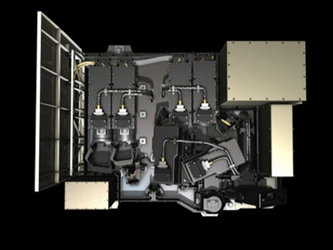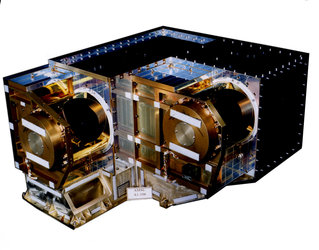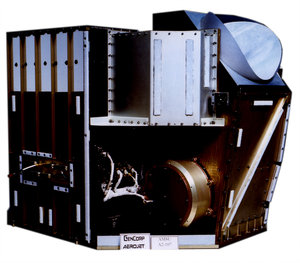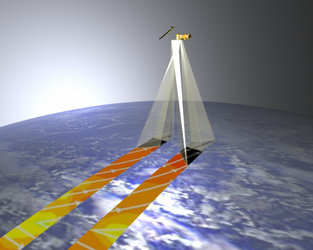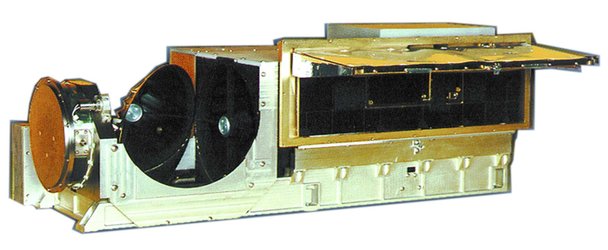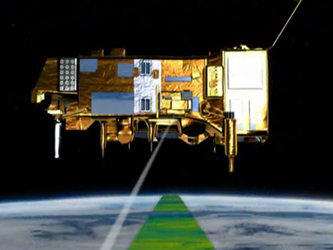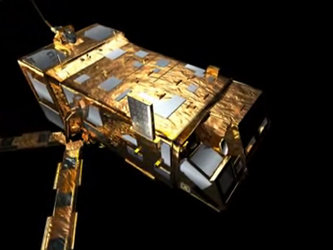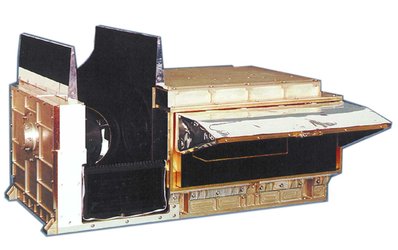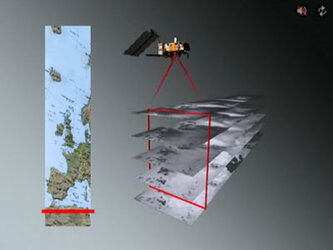GOME-2 focal-plane assemblies
GOME-2 has a total of six Focal Plane Assemblies (FPAs), four devoted to the main spectrometer channels and two to the new polarisation channels. The basic design for the four main-spectrometer FPAs is very similar to that for GOME-1, with titanium being used for the structure and a quartz window on the side where it is assembled on the spectrometer objective. Each FPA contains a random-access linear silicon photodiode array, consisting of 1024 elements each 2.5 x 0.025 mm2 (type Reticon RL 1024 SRU), which is reverse-biased and operates in charge accumulation mode.
To achieve maximum sensitivity, the detector has to be cooled to -38°C by means of a thermoelectric cooler on the bottom face of the detector. To reject the heat generated by the cooler, a low-resistance thermal path to the main GOME-2 radiator is provided by two heat pipes, and some specially designed parts to absorb the effects of thermal expansion. The detector temperature is controlled in closed loop by a suitable electronic circuit inside the Control and Data Handling Unit; the actual target temperature can be programmed in-flight to any value between ambient and -38°C. Based on GOME-1 experience, stability is better than ± 0.1°C.
To avoid ice formation during ground testing, each FPA has a vacuum-tight enclosure containing the detector and cooler. This enclosure can be evacuated via a system of pipes on the bottom of the optical bench and a tap on the back of the instrument, which will be removed just before launch, allowing the FPAs to evacuate naturally during the ascent phase.
The FPA electronics is split onto two boards. The first carries the charge amplifier, made up of a dual-FET differential stage and a low-noise amplifier. To achieve maximum noise immunity, this board is installed on the rear of the vacuum enclosure, just 3 cm from the detector. The second board is mounted on top of the spectrometer objective, and contains some filtering circuits, the 16-bit A/D converter and the interfaces. Thanks to the modular approach, each FPA can be tested and trimmed at module level before final integration on the instrument. Testing has shown that, due to their careful design, the FPA electronics have low noise and a dynamic range of about 30 000.
There are 255 integration times possible, ranging from 93.75 msec to more than 1 h. In channels 1 and 2, two different integration times can be selected for two bands of the detector; and the border between the two bands is in-flight programmable.
The two Polarisation Unit FPAs are slightly different. Due to the less-demanding detection performance needs and the more stringent requirements on mechanical accommodation, no closed-loop thermal control has been implemented. Consequently, neither the thermal link to the radiator nor the vacuum-tight enclosure is present, with very beneficial effects in terms of mass savings and structural robustness. The detector is cooled anyway in open-loop configuration to about 0°C by a thermoelectric element, which rejects heat to the main optical bench through the PU mechanics. Although not stabilised, the detector temperature is kept low enough for the dark current effect to be neglected in this particular case. The detection electronics is the same as for main-channel FPAs. Integration time will normally be fixed at 23.4 msec, and the spectral information will be grouped in 12 fully programmable bands (300 – 790 nm). The integration time can be programmed as per the main-channel FPAs during calibration phases.




